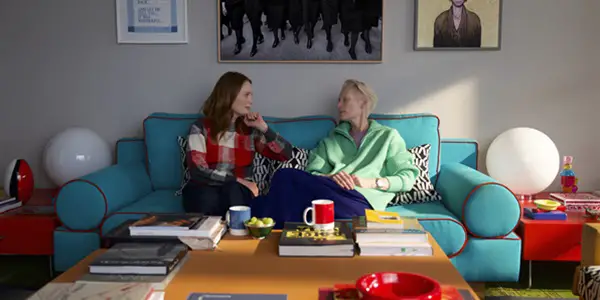New York Film Festival 2024: By the Stream, A Traveler’s Needs, The Room Next Door

Lee Jutton has directed short films starring a killer toaster,…
Certain filmmakers are such mainstays of the New York Film Festival that you can pretty much guarantee that if they have a new film coming out, it will be screening at Alice Tully Hall in the fall. Two such filmmakers are the prolific South Korean director Hong Sang-soo
, who generally has not one, but two, films screening at each iteration of the festival, and legendary Spanish auteur Pedro Almodóvar, who loves the NYFF so much that he set a scene in his latest movie at Alice Tully Hall as a tribute to the festival. (If the selection committee wasn’t already considering showing his latest film—and let’s be real, they were always going to show it—their decision must have been set in stone at that very moment.) Read on for my thoughts on these directors’ latest films, which (naturally) screened as part of the Main Slate at this year’s NYFF.
By the Stream (Hong Sang-soo)
If you are a card-carrying member of the cult of Hong Sang-soo (Are there cards? I would like a card), you generally know what to expect when he releases a new movie. There will be long scenes of incisive conversation; characters who work in the arts, often played by the same reliable members of Hong’s stock ensemble; and soju—lots and lots of soju. (Sometimes he switches the soju out for makgeolli, but the overall effect is the same.) His recent films are generally quite short, sometimes clocking in at just over an hour, and they tend to play around with timelines, mixing up the order of scenes and repeating them from alternate perspectives to force the audience to question initial assumptions of what is true. That’s why By the Stream—a film running close to two hours with a relatively straightforward plot—feels like somewhat of a departure for Hong, even if it features familiar faces and deals with familiar topics from many of his other recent movies.

Textile artist and college lecturer Jeong-im (Hong’s partner and muse Kim Min-hee, who won the Pardo for Best Performance at this year’s Locarno Film Festival) enlists her uncle, former actor and director Si-eon (Hong’s go-to screen surrogate, Kwon Hae-hyo) to direct a skit put on by the students in her department as part of the college’s annual festival. Si-eon is replacing a younger man who threw the ensemble into upheaval when he dated three of the women in it at the same time; the dramatic fallout from his actions is compounded when he continues pursuing one of the women, much to Jeong-im’s dismay. (The scene in which Jeong-im encounters this guy on campus and angrily throws him out is amazing; if Kim Min-hee spoke to me like that I would question every decision I had ever made leading up to that moment.)
But that’s not all. Turns out, Jeong-im’s boss at the college, Jeong (Cho Yun-hee), is a big fan of Si-eon’s work; their relationship quickly evolves from that of fan and artist to something much more personal…again, much to Jeong-im’s dismay. Si-eon’s increasingly intimate involvement with Jeong echoes the romantic drama caused by the departed-yet-still-lurking student director and the romantic drama Si-eon got tangled up as a young man directing a different skit at the same school so many years ago. All of these personal issues threaten to get in the way of the skit and keep it from ever reaching the stage—not to mention, put Jeong and Jeong-im’s jobs in jeopardy.

By the Stream doesn’t utilize the nonlinear storytelling techniques—scenes repeating, echoing, and folding inward on each other—that make Hong films like Virgin Stripped Bare by Her Bachelors and Walk Up so fascinating to watch and interpret. If anything, the linear nature of the narrative is emphasized by the recurring device of having the beginning of each new day represented on screen by Kim appearing at the side of a stream to observe the flow of the water and create sketches for her art projects; when she doesn’t appear there towards the end of the film, you know something big has happened. (Kim is, as usual, excellent, with her quiet charisma running like a gentle current through each scene she appears in.) However, that isn’t to say the film isn’t still preoccupied with the past and perspective—after all, it’s still a Hong movie. The male characters in By the Stream both carry baggage in the form of previous transgressions; the younger man, too close to the events that have just happened, is defensive and has no regrets, while the older man, who has had time to meditate on what he’s done, is much more understanding of why people would be upset with him.
It’s impossible to hear Si-eon relay the stories of his previous romantic foibles or the reasons why he feels happy with Jeong and not think you’re hearing echoes of Hong himself justifying while also seeking forgiveness for the affair with Kim that destroyed his previous marriage, which technically still exists because his wife won’t give him a divorce. Is this movie his argument that he deserves one? That would be too simplistic an interpretation. It’s certainly about forgiveness, though, and second chances, and the experiences you gather throughout life that make you view the events of the past through a different lens. Perhaps this time both men onscreen are stand-ins for the evolution of Hong—the younger, brasher, up-and-coming director and the older, wiser, more contemplative master.
A Traveler’s Needs (Hong Sang-soo)
In contrast, A Traveler’s Needs doesn’t really have a Hong surrogate at all. What it does have is the wonderful French actress, Isabelle Huppert, in her third collaboration with Hong following Claire’s Camera and In Another Country: a triptych of loosely connected stories in which she terrorizes the well-to-do people of Seoul with her unconventional methods of teaching French and her obsession with drinking makgeolli. We’re not sure why or how her character, Iris, ended up in South Korea, where she was discovered poorly playing the recorder on a bench in the park by a young man who then brought her home to live with him (something that could only happen to a woman as magnetic as Huppert). What we do know is that her unorthodox teaching methods likely allow her to delve more deeply into her students’ psyches than they allow her students to delve into the French language.

Basically, Iris spends her time hanging out with her students—chatting with them, going for walks with them, and most importantly, drinking their makgeolli—until something sparks in her head and she asks them to explain their innermost thoughts on a specific topic. That both sets of people must speak English to communicate—the first language of neither—only adds to the layers of potential misunderstanding and miscommunication in such a scenario, and indeed, Iris ends up interpreting her students’ relatively shallow comments about their feelings into intense expressions of insecurity and vulnerability.
Iris then writes these statements in French on index cards for her students; by repeating these sentences, she insists, they’ll be able to speak French better because they’ll know how to express true feelings with the language instead of just mundane tourist-friendly terms. But are Iris’ somewhat warped renditions of their feelings that she writes on the index cards actually representative of her students’ true feelings or her own? Either way, these lessons (and the makgeolli) provide a balm to soothe the loneliness of being stranded in a foreign country where the only way to get by is to speak a language that isn’t yours, making it even more difficult than it already is to find real human connection.
It is always a joy to watch Huppert on screen, even in a film as flimsy as A Traveler’s Needs—and it’s flimsy almost to the point of being transparent, relying entirely on Huppert’s considerable star power to hold your attention. It doesn’t help that the character of Iris is enigmatic almost to a fault, drifting through the film in a floral sundress and a quirky straw hat, intriguing everyone who crosses her path with her idiosyncratic behavior while giving away very little as to what actually makes her tick. Iris is not exactly a Manic Pixie Dream Girl—how could she be, she’s Isabelle Huppert—but I’d be lying if I said she didn’t make that archetype rise back up to the surface of my mind after a long absence.
The middle portion of the film, in which Iris upends the afternoon of a middle-aged bourgeois couple (and gets a lot of hearty laughs out of the flirtatious husband, played by Kwon Hae-hyo), is the most enjoyable, filled with awkward humor, gentle culture clashes, and what may be the greatest zoom in a cinematic oeuvre filled with great zooms. (You’ll know it when you see it.) But when Iris goes home to the small flat she shares with In-guk (Ha Song-guk), only for his mother to abruptly show up and discover that her son is living with a strange woman from another country who is old enough to be his mother, things devolve from being lightly entertaining to being an unpleasant mixture of dull and grating. It doesn’t help that Huppert is largely offscreen while mother and son argue about whether or not it’s important to know anything about Iris’ past; her presence would have added some extra amusement to proceedings. In the end, what we’re left with can only be described as a minor Hong film, one whose pleasures, as enjoyable as they may be in the moment, evaporate too quickly to have an impact.
The Room Next Door (Pedro Almodóvar)
After trying his hand at English-language short films The Human Voice and Strange Way of Life—both of which screened at previous iterations of the NYFF—Pedro Almodóvar has made his first English-language feature film, adapted from the novel What Are You Going Through by Sigrid Nunez. Winner of the Golden Lion at this year’s Venice Film Festival, The Room Next Door tells the story of two women who reconnect after a long time apart when one, who is terminally ill, asks the other to be present when she decides to end her own life. A deeply compassionate and visually sumptuous melodrama featuring two great actresses at the top of their game, The Room Next Door might not be in Spanish, but it is still quintessential Almodóvar.

Bestselling author Ingrid (Julianne Moore) is signing copies of her latest book—one that deals with her long-standing fear of death—when she learns that an old friend, former war correspondent Martha (Tilda Swinton) has cervical cancer. Ingrid and Martha were close in their youth when they worked for the same magazine in New York; since then, Ingrid has been living in Paris and the two of them have lost touch. However, when Ingrid visits Martha in the hospital, the years that could have stood like a barrier between them simply melt away. Their honest, intimate conversations will ring true to anyone who has ever caught up with a close friend after a long time and discovered how easy it is to start back up again with someone who really, truly knows you; you can skip over the mundane details of life and get straight to the stuff that matters.
When Martha learns that her cancer is terminal, she decides to forgo the additional pain and trauma of treatments that will only prolong the inevitable and makes plans to end her own life. As part of those plans, she asks Ingrid to come with her on a trip to a lovely house in the country, just so that she can have someone in the room next door the night she decides to die. While Ingrid’s fears make her a less than ideal choice for such a companion, she puts her reluctance aside for the sake of Martha. What results is a strangely sweet story about two women brought together by their complicity, and the things they learn—about life and death, themselves and each other—in the process. It is often devastatingly sad, but never without hope, not even when facing the hate and horrors that plague the world, so angrily articulated on screen by the former lover of both women (John Turturro) during an afternoon of drinks with Ingrid.
The Room Next Door is unmistakably Almodóvar: from the melodramatic tone to the intensely personal dialogue (which takes a while to get used to hearing in English instead of Spanish) to the gorgeous jewel-toned sets and costumes. As Swinton so wonderfully put it during the NYFF press conference, “Everyone in Pedro’s films dresses not only for each other, but for Pedro. That’s what color is for.” Indeed, costume designer Bina Daigeler, who previously collaborated with Almodóvar on two of his best features (All About My Mother and Volver), outfits the leads in luxurious-looking textiles—thick sweaters, big coats—in rich colors that contrast beautifully with the pale skin of both actresses. As the film progresses, and the two women grow closer, one gets a sense that they’re dressing more and more alike, influenced by each other while also seeking to impress each other.

The sets dreamed up by production designer and art director Inbal Weinberg—from Martha’s luxurious private hospital room to the chic decor of her sprawling apartment to the strikingly modern house she rents for her final goodbye—make it clear that the protagonists of The Room Next Door are not average New Yorkers, but extremely wealthy people. Some people may be put off by that; after all, it’s clear that the whole enterprise, including Martha scouring the dark web to find an illegal euthanasia pill that normal people would probably not be able to get their hands on, is something only that could only be arranged by the very privileged. However, the incredible performances of Swinton and Moore go along way towards ensuring you’ll still empathize with these characters. The two of them have been delivering top-notch performances for years, but here, together, they do some of their best work; their natural chemistry is what makes Martha and Ingrid’s deep friendship so believable and engaging.
These characters are brought to vivid life on screen not just by these great actresses, but by Almodóvar’s decision to fill the film with references to art, movies, and books that the two of them love and share. In one the film’s most endearing scenes, Martha and Ingrid decide to stay up all night watching movies, cackling their way through Buster Keaton’s antics in Seven Chances before moving on to the tragic romance of Letter from an Unknown Woman (“The love story should be sad to be good,” according to Almodóvar), and finally, John Huston’s adaptation of James Joyce’s The Dead. In that film’s final scene, a character delivers a lovely monologue in which he imagines the snow falling all over Ireland “upon all the living and the dead.” Martha has seen the film so many times that she knows these words by heart, and as you watch her recite along with the film while Ingrid silently listens, you cannot help but be struck by the beauty of it all. What more can you ask from a film by Almodóvar?
By the Stream, A Traveler’s Needs, and The Room Next Door screened as part of the Main Slate at the 2024 New York Film Festival. A Traveler’s Needs opens in select theaters on November 22, 2024.
Does content like this matter to you?
Become a Member and support film journalism. Unlock access to all of Film Inquiry`s great articles. Join a community of like-minded readers who are passionate about cinema - get access to our private members Network, give back to independent filmmakers, and more.
Lee Jutton has directed short films starring a killer toaster, a killer Christmas tree, and a not-killer leopard. Her writing has appeared in publications such as Film School Rejects, Bitch: A Feminist Response to Pop Culture, Bitch Flicks, TV Fanatic, and Just Press Play. When not watching, making, or writing about films, she can usually be found on Twitter obsessing over soccer, BTS, and her cat.












